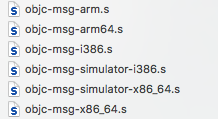Objective-C runtime源碼學習之IMP尋址(不包括消息轉發部分)
寫在前面
這是在看《招聘一個靠譜的iOS》時回答第22題時總結的一篇博客,不過這篇博客中並沒有牽涉到底層的代碼,而且也留下了幾個沒有解決的問題,這篇博客將深入runtime源碼繼續探索這個問題,並嘗試解決上篇博客中未解決的問題,本人第一次閱讀源碼,如果有分析錯誤的地方,歡迎大家糾正。
引入
首先大家都知道,在oc中調用方法(或者說發送一個消息是)runtime底層都會翻譯成objc_msgSend(id self, SEL op, ...),蘋果為了優化性能,這個方法是用匯編寫成的
/********************************************************************
*
* id objc_msgSend(id self, SEL _cmd,...);
*
********************************************************************/
ENTRY objc_msgSend
# check whether receiver is nil
teq a1, #0
beq LMsgSendNilReceiver
# save registers and load receiver's class for CacheLookup
stmfd sp!, {a4,v1}
ldr v1, [a1, #ISA]
# receiver is non-nil: search the cache
CacheLookup a2, v1, LMsgSendCacheMiss
# cache hit (imp in ip) and CacheLookup returns with nonstret (eq) set, restore registers and call
ldmfd sp!, {a4,v1}
bx ip
# cache miss: go search the method lists
LMsgSendCacheMiss:
ldmfd sp!, {a4,v1}
b _objc_msgSend_uncached
LMsgSendNilReceiver:
mov a2, #0
bx lr
LMsgSendExit:
END_ENTRY objc_msgSend
實話說我沒有學過匯編,所以看到這段代碼我的內心是崩潰的,更可怕的是針對不同的平台,還有不同匯編代碼的實現

雖然不懂匯編,但是蘋果的注釋很詳細,看注釋也可以大致明白在干什麼,首先檢查傳入的self是否為空,然後根據selector尋找方法實現IMP,找到則調用並返回,否則拋出異常。由此可以有以下偽代碼
id objc_msgSend(id self, SEL _cmd, ...) {
Class class = object_getClass(self);
IMP imp = class_getMethodImplementation(class, _cmd);
return imp ? imp(self, _cmd, ...) : 0;
}
偽代碼中我們看到class_getMethodImplementation(Class cls, SEL sel) 方法用來尋找IMP地址,有趣的是蘋果真的提供了這個方法,可以讓我們調用,通過selector去尋找方法實現IMP,而這個函數的實現,以及其延伸就是這篇博客所要探討的重點。
正文
在我前面的文章中也說到IMP尋址總共有兩種方法:
IMP class_getMethodImplementation(Class cls, SEL name); IMP method_getImplementation(Method m);
而在NSObject中提供了幾個對class_getMethodImplementation封裝的方法
+ (IMP)instanceMethodForSelector:(SEL)sel {
if (!sel) [self doesNotRecognizeSelector:sel];
return class_getMethodImplementation(self, sel);
}
+ (IMP)methodForSelector:(SEL)sel {
if (!sel) [self doesNotRecognizeSelector:sel];
return object_getMethodImplementation((id)self, sel);
}
- (IMP)methodForSelector:(SEL)sel {
if (!sel) [self doesNotRecognizeSelector:sel];
return object_getMethodImplementation(self, sel);
}
但這些方法卻並沒有在頭文件中暴露,所以我並不明白蘋果這樣做的用意,如果有人知道,希望能夠告知,感激不盡!
這裡出現的object_getMethodImplementation其實就是對class_getMethodImplementation的封裝,蘋果的解釋是:
Equivalent to: class_getMethodImplementation(object_getClass(obj), name);
下面我們就暫時把目光轉向class_getMethodImplementation這個函數,看看它底層到底是如何實現的
IMP class_getMethodImplementation(Class cls, SEL sel)
{
IMP imp;
if (!cls || !sel) return nil;
imp = lookUpImpOrNil(cls, sel, nil,
YES/*initialize*/, YES/*cache*/, YES/*resolver*/);
// Translate forwarding function to C-callable external version
if (!imp) {
return _objc_msgForward;
}
return imp;
}
首先判斷傳入的參數是否為空,然後進入lookUpImpOrNil這個方法,實際上這個這個方法是對lookUpImpOrForward的簡單封裝:
/***********************************************************************
* lookUpImpOrNil.
* Like lookUpImpOrForward, but returns nil instead of _objc_msgForward_impcache
**********************************************************************/
IMP lookUpImpOrNil(Class cls, SEL sel, id inst,
bool initialize, bool cache, bool resolver)
{
IMP imp = lookUpImpOrForward(cls, sel, inst, initialize, cache, resolver);
if (imp == _objc_msgForward_impcache) return nil;
else return imp;
}
注釋寫的也很清楚,這個方法不會進行消息的轉發,而直接返回nil,這個倒是比較有趣,明明調用lookUpImpOrForward可以直接進行消息轉發,可是這裡偏不這樣做,調用消息轉發返回nil的函數,然後判斷imp為nil時,自己手動返回_objc_msgForward,進行消息轉發,還真是有意思,不過蘋果在這裡做了注釋:Translate forwarding function to C-callable external version,將這個轉發函數轉換為C語言能夠調用的版本。
接下來我們繼續深入,看一下lookUpImpOrForward是如何實現的:
IMP lookUpImpOrForward(Class cls, SEL sel, id inst,
bool initialize, bool cache, bool resolver)
{
Class curClass;
IMP methodPC = nil;
Method meth;
bool triedResolver = NO;
methodListLock.assertUnlocked();
if (cache) {
methodPC = _cache_getImp(cls, sel);
if (methodPC) return methodPC;
}
if (cls == _class_getFreedObjectClass())
return (IMP) _freedHandler;
}
retry:
methodListLock.lock();
// Ignore GC selectors
if (ignoreSelector(sel)) {
methodPC = _cache_addIgnoredEntry(cls, sel);
goto done;
}
// Try this class's cache.
methodPC = _cache_getImp(cls, sel);
if (methodPC) goto done;
// Try this class's method lists.
meth = _class_getMethodNoSuper_nolock(cls, sel);
if (meth) {
log_and_fill_cache(cls, cls, meth, sel);
methodPC = method_getImplementation(meth);
goto done;
}
// Try superclass caches and method lists.
curClass = cls;
while ((curClass = curClass->superclass)) {
// Superclass cache.
meth = _cache_getMethod(curClass, sel, _objc_msgForward_impcache);
if (meth) {
if (meth != (Method)1) {
// Found the method in a superclass. Cache it in this class.
log_and_fill_cache(cls, curClass, meth, sel);
methodPC = method_getImplementation(meth);
goto done;
}
else {
// Found a forward:: entry in a superclass.
// Stop searching, but don't cache yet; call method
// resolver for this class first.
break;
}
}
// Superclass method list.
meth = _class_getMethodNoSuper_nolock(curClass, sel);
if (meth) {
log_and_fill_cache(cls, curClass, meth, sel);
methodPC = method_getImplementation(meth);
goto done;
}
}
// No implementation found. Try method resolver once.
if (resolver && !triedResolver) {
methodListLock.unlock();
_class_resolveMethod(cls, sel, inst);
triedResolver = YES;
goto retry;
}
// No implementation found, and method resolver didn't help.
// Use forwarding.
_cache_addForwardEntry(cls, sel);
methodPC = _objc_msgForward_impcache;
done:
methodListLock.unlock();
// paranoia: look for ignored selectors with non-ignored implementations
assert(!(ignoreSelector(sel) && methodPC != (IMP)&_objc_ignored_method));
return methodPC;
}
我天,好長的一段代碼,我刪了好多注釋,還是很多
首先這裡有一個我並不懂的東西methodListLock.assertUnlocked(); 我看到Objective-C 消息發送與轉發機制原理 中對此的解釋是
對 debug 模式下的 assert 進行 unlock,runtimeLock 本質上是對 Darwin 提供的線程讀寫鎖 pthread_rwlock_t 的一層封裝,提供了一些便捷的方法。
需要注意的是在objc-runtime-new.mm中有一段幾乎相同的lookUpImpOrForward的實現,在該實現中,加鎖操作是runtimeLock.read(); 所以這篇上述博客使用的代碼應該是objc-runtime-new.mm的代碼,而我的源碼是來自於objc-class-old.mm 雖然名稱不同,但我想底層應該是一樣的。
很佩服這位博主對底層認識的如此深刻,我們暫時就按照這裡寫的理解,繼續往下看
無鎖的緩存查找(Optimistic cache lookup)
在沒有鎖的狀態下進行緩存搜索,性能會比較好
if (cache) {
methodPC = _cache_getImp(cls, sel);
if (methodPC) return methodPC;
}
首先如果cache傳入的是YES,則調用cache_getImp在緩存中搜索,當然這裡傳入的是YES(而在objc_msgSend方法裡在這裡進行了優化,objc_msgSend最開始就在緩存中進行了搜索,所以有了一個很有趣的方法_class_lookupMethodAndLoadCache3,這個方法在調用lookUpImpOrForward時傳入cache是NO,避免兩次搜索緩存),而cache_getImp 是用匯編寫的(又是匯編。。。(T_T))
STATIC_ENTRY cache_getImp
mov r9, r0
CacheLookup GETIMP // returns IMP on success
LCacheMiss:
mov r0, #0 // return nil if cache miss
bx lr
LGetImpExit:
END_ENTRY cache_getImp
具體的緩存搜索是在宏CacheLookup 中實現的,具體這裡就不展開了(也展開不了,我還沒看懂(^-^) )。
釋放檢測
if (cls == _class_getFreedObjectClass())
return (IMP) _freedHandler;
檢測發送消息的對象是否已經被釋放,如果已經釋放,則返回_freedHandler 的IMP
static void _freedHandler(id obj, SEL sel)
{
__objc_error (obj, "message %s sent to freed object=%p",
sel_getName(sel), (void*)obj);
}
在該方法中拋出message sent to freed object的錯誤信息(不過我還從來沒有遇到過這樣的錯誤信息)
初始化檢查
if (initialize && !cls->isInitialized()) {
_class_initialize (_class_getNonMetaClass(cls, inst));
}
這裡我不是很理解+initialize方法是做什麼的
// +initialize bits are stored on the metaclass only
bool isInitialized() {
return getMeta()->info & CLS_INITIALIZED;
}
但是從isInitialized() 的實現來看初始化的信息保存在元類中,由此推測是元類或者是類對象的初始化工作,而我在上文中提到的博客中是這樣寫的:
如果是第一次用到這個類且 initialize 參數為 YES(initialize && !cls->isInitialized()),需要進行初始化工作,也就是開辟一個用於讀寫數據的空間。先對 runtimeLock 寫操作加鎖,然後調用 cls 的 initialize 方法。如果 sel == initialize 也沒關系,雖然 initialize 還會被調用一次,但不會起作用啦,因為 cls->isInitialized() 已經是 YES 啦。
這裡的表述也大致印證了我的猜測,是對類對象或者是元類對象進行初始化的工作,不過我還是有一點不明白:類對象都還沒有初始化,那是如何產生這個類的實例對象呢?然而在別人博客中看到:+load是在runtime之前就被調用的,+initialize是在runtime才調用
retry語句標號(在該類的父類中查找)
這裡對方法列表進行了加鎖的操作methodListLock.lock();
The lock is held to make method-lookup + cache-fill atomic with respect to method addition. Otherwise, a category could be added but ignored indefinitely because the cache was re-filled with the old value after the cache flush on behalf of the category.
考慮運行時方法的動態添加,加鎖是為了使方法搜索和緩存填充成為原子操作。否則category添加時刷新的緩存可能會因為舊數據的重新填充而被完全忽略掉。
typedef struct {
SEL name; // same layout as struct old_method
void *unused;
IMP imp; // same layout as struct old_method
} cache_entry;
//objective-c 2.0以前
struct old_method {
SEL method_name;
char *method_types;
IMP method_imp;
};
typedef struct old_method *Method;
//objective-c 2.0
struct method_t {
SEL name;
const char *types;
IMP imp;
struct SortBySELAddress :
public std::binary_function
{
bool operator() (const method_t& lhs,
const method_t& rhs)
{ return lhs.name < rhs.name; }
};
};
typedef struct method_t *Method;
檢查selector是否是垃圾回收方法,如果是則填充緩存_cache_fill(cls, (Method)entryp, sel);(這裡entryp的類型是結構體cache_entry,將其強轉為Method,我們可以看到上面的代碼,OC2.0前,這個cache_entry和method的定義幾乎是相同的,2.0後加入了一個我完全看不懂的東西(T_T))並讓methodPC指向該方法的實現即entryp->imp(實際上這是一個匯編程序的入口_objc_ignored_method),然後跳轉到done語句標號。否則進行下一步 在本類的緩存中查找,也是使用匯編程序入口_cache_getImp,如果找到,跳轉到done語句標號,否則進行下一步。 在上一步緩存中沒有發現,然後進入本類的方法列表中查找,如果找到了則進行緩存填充,並讓methodPC指向該方法的實現,跳轉到done語句標號,否則進行下一步。 在父類的方法列表和緩存中遞歸查找,首先是查找緩存,又是調用一個匯編的程序入口_cache_getMethod 比較奇怪的是我只在objc-msg-i386.s中發現了這個程序入口,與前面不同的是,這裡傳入了一個_objc_msgForward_impcache 的匯編程序入口作為緩存中消息轉發的標記,如果發現緩存的方法,則使method_PC指向其實現,跳轉到done語句標號,如果找到了Method,但發現其IMP是一個轉發的匯編程序入口即_objc_msgForward_impcache ,立即跳出循環,但是不立刻緩存,而是call method resolver,即進行第5步。如果緩存中沒發現Method,就在列表中尋找,同樣是找到即跳轉到done,否則進行下一步。 當傳入的resolver為YES且triedResolver為NO時(即此步驟只會進入一次,進入後triedResolver會設為YES),進入method resolver(動態方法解析),首先對methodListLock解鎖,然後調用_class_resolveMethod 發送_class_resolveInstanceMethod 或_class_resolveClassMethod 消息,程序員此時可以動態的給selector添加一個對應的IMP。完成後再回到第1步重新來一遍。這一步消息轉發前最後一次機會。 沒有找到方法的實現,method resolver(動態方法解析)也沒有作用,此時進行消息的轉發,使methodPC指向_objc_msgForward_impcache 匯編程序入口,並進入done。
done語句標號
首先將methodListLock解鎖,然後斷言不會存在一個被忽略的selector其implementation是沒有被忽略的(官方的意思是非要找到這樣一個selector,真是有趣)
paranoia: look for ignored selectors with non-ignored implementations
最後返回這個methodPC。
然後就是消息轉發部分了,其objc_setForwardHandler實現機制不在Objective-C Runtime (libobjc.dylib)中,而是在CoreFoundation(CoreFoundation.framework)中,所以這裡就先不討論了,等我以後研究了那部分以後,再專門寫一篇關於消息轉發的博客。
關於正文開始處所說的第二種方法method_getImplementation(),首先需要調用class_getInstanceMethod() 而在這個方法裡加了一個warning
#warning fixme build and search caches
// Search method lists, try method resolver, etc.
lookUpImpOrNil(cls, sel, nil,
NO/*initialize*/, NO/*cache*/, YES/*resolver*/);
#warning fixme build and search caches
我這裡調用了lookUpImpOrNil方法,卻沒有使用其返回值,而且標注需要fix and search caches,我猜測可能因為某種原因,在這裡無法進行緩存查找,而後面return _class_getMethod(cls, sel);本質上就是在方法列表中進行查找,而且也沒有進行消息轉發。
這裡也印證了蘋果對於這個方法的注釋:class_getMethodImplementation may be faster than method_getImplementation(class_getInstanceMethod(cls, name)),因為第一個方法進行了緩存的查找,如果緩存中能找到,效率會提高很多。
以前的問題
在我上一篇博客runtime如何通過selector找到對應的IMP地址?(分別考慮類方法和實例方法)裡我有一個沒有解決的問題:為什麼對於無法找到的IMP,class_getMethodImplementation(),method_getImplementation()返回值會不一樣?
IMP method_getImplementation(Method m)
{
return m ? m->imp : nil;
}
看完源碼,就很清楚了,如果這個method不存在,直接返回nil,而
class_getMethodImplementation()會經歷消息轉發機制,最後返回的是forwardInvocation的結果,而這部分是不開源的,也不知道具體是怎麼返回的,但每次運行確實是會返回的一個固定的地址,我猜測最後這個地址可能和NSInvocation這個對象的內存地址有關,具體那是什麼地址,以後有機會在去尋找答案。
- 上一頁:對iOS10新增Api的詳細探究
- 下一頁:iOS10兼容
- Objective-C 宏界說具體引見
- Objective-C 代碼與Javascript 代碼互相挪用實例
- Objective-C 經典字典數組排序 - 省郊區
- iOS中應用JSPatch框架使Objective-C與JavaScript代碼交互
- Objective-C完成自界說的半通明導航
- Objective-C的緩存框架EGOCache在iOS App開辟中的應用
- Objective-C的入門進修筆記
- Objective-C完成無窮輪回輪播器
- iOS App開辟中Objective-C應用正則表達式停止婚配的辦法
- 淺析Objective-C的法式構造及面向對象的編程方法
- Objective-C中字符串NSString的經常使用操作辦法總結
- Objective-C編程中語句和變量的一些編寫標准建議
- Objective-C中編程中一些推舉的書寫標准小結
- 舉例講授Objective-C中@property屬性的用法
- 詳解Obejective-C中將JSON數據轉為模子的辦法




